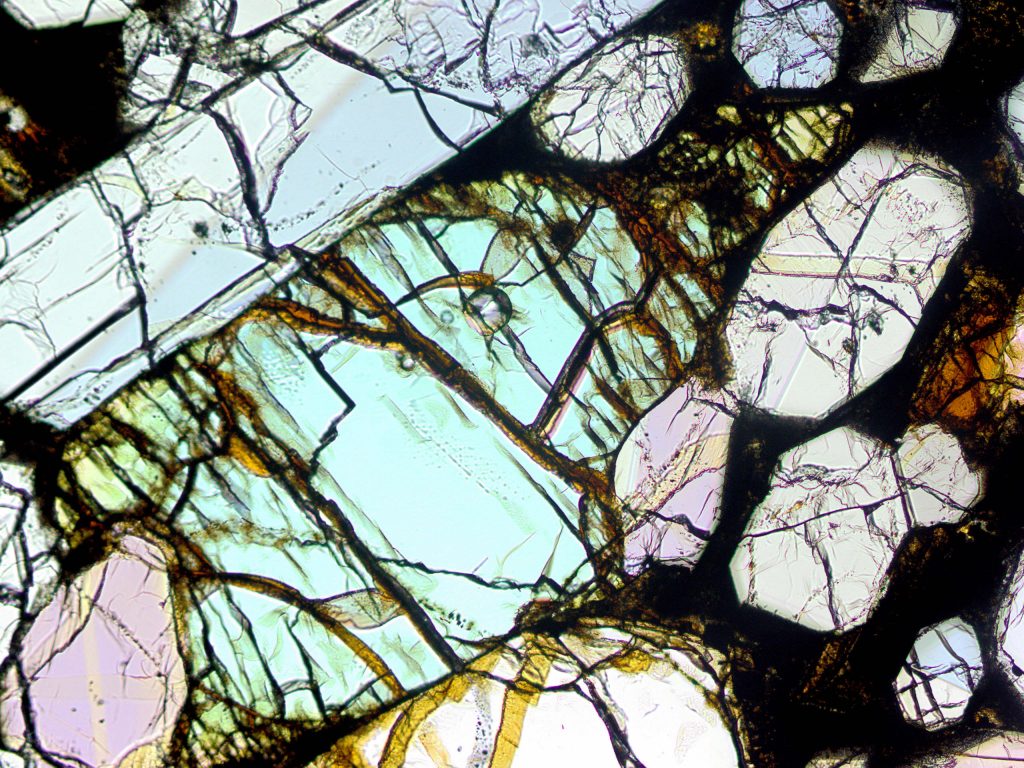Nobody knew how the rock ended up there. Staff were not even sure if it was a rock from space, nor where it came from.
This is the story of how planetary scientist Lydia Hallis happened to come across that meteorite, and how she became a member of the Mars Sample Return science group that works to get the most scientific value from the martian samples that are planned to arrive on Earth in the next decade.
The story of Lafayette
Nearly a century after the meteorite was picked up, Lydia treasures a piece of the meteorite on the other side of the Atlantic Ocean, in her home in Scotland. The sample was loaned to her by the Natural History Museum in London, UK, for research.
Martian meteorites are so precious some of them even have names. This one is called Lafayette.
“Of the over one hundred martian meteorites we have in our records, most are found in deserts or in Antarctica. They have been sitting on Earth for maybe thousands of years, so they show a lot of extra minerals produced by the interaction with water,” explains Lydia.

“It was important to figure out whether Lafayette has been on Earth for a long time or whether it was picked up straight away after falling. There were stories about a student witnessing the fall while fishing, picking it up from a pond and bringing it to the university,” says Lydia.
If the story was true, that would prove that the water interaction with the meteorite was minimal.
Lydia and her student Aine O’Brien, from the same School of Geographical and Earth Sciences at the University of Glasgow, decided to investigate. They looked at the organic terrestrial contaminants in the meteorite using a method called liquid chromatography mass-spectrometry, a technique used in forensic science.
After some detective work together with archivists from Purdue University, Aine managed to locate where Lafayette fell to Earth, establish the year and even narrowed down the collector to a handful of students. “It is a cool side story for a precious martian meteorite,” Lydia concedes.

“What makes this meteorite martian is the alteration veins of clay inside the olivine crystals. That is not a typical sign of weathering on Earth. This must have happened on the surface of Mars,” she explains.
So Lafayette is one of the few martian meteorites available for study that have very little terrestrial contamination or alterations.
Love of meteorites
The Lafayette story is just one of the love stories Lydia has for meteorites. This lecturer in planetary science cares about the samples and has a direct contact with them. When she is in the lab, she likes to examine them in every possible way.
Part of her research involves chemical analyses of the minerals inside meteorites to help us better understand planetary formation and geological processes. She uses state-of-the-art techniques to investigate martian meteorites at atomic scales.

From London to Hawaii via Antarctica
Lydia’s path to becoming an expert in handling and curating extraterrestrial samples stretches worldwide.
When she was finishing her PhD at the Natural History Museum in London with the Open University, a casual chat over champagne at a meteoritical society conference in France led her to apply for a position in Hawaii. Despair with the struggle of writing her thesis was building up, until a collection of martian samples caught her eye.
“After looking for so long at lunar samples for my doctorate, the alterations and complexity of martian meteorites attracted me,” she confesses. “The possible interactions with liquid water intrigued me.”

Even if the Lafayette meteorite was found and stored straight away, water is in the atmosphere and everywhere on Earth – even inside a drawer. The water leaves a signature based on its molecular structure: hydrogen isotopes in the martian atmosphere are different from Earth atmosphere.
Volcanic euruptions of volatile elements helped form Earth’s oceans and our thick, protective atmosphere, making our planet a haven for life as we know it. “Knowing the stability and fate of the martian atmosphere is key to understanding whether life developed on the Red Planet. That is why I am currently focusing my research on the martian carbon and hydrogen cycles in meteorites,” she explains.

To prove that minerals are martian, she and her colleagues in Hawaii used an instrument called an ion probe to measure the hydrogen isotopes. “That was really exciting. We found a way to trace water sources in the Solar System, not just from Mars,” says Lydia.
Lydia is also part of the team that keeps track of the set of meteorites brought back from Antarctic expeditions every year. Her experience is of great value for the Mars Sample Return campaign science group.
“Our biggest goal as a team is to advise which instruments we need in the lab and how do we best protect the samples from any kind of contamination during curation and analysis, but also to decide how we can get the best science out of them once they land on Earth.”
“We will make sure that the pristine martian samples don’t ever go unnoticed inside a drawer,” she assures.

Discussion: one comment
Rum is important, but maybe try the
Ardnamurchan peninsular?
The ring formation is old volcanic.